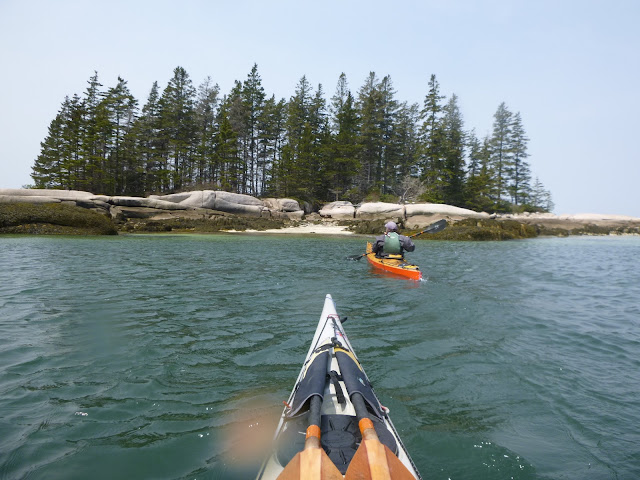Sometimes, during the first five minutes of a paddle it
feels like hard work, and I wonder: how am I going to go x miles today? And
then, hopefully, we become a little less aware of the effort, focusing on
executing a clean and efficient forward stroke, making a few turns around the
rocks along shore, and maybe we start chatting. The miles go past, we get where
we’re going, a little more worn-out than maybe we’d like, but we’re paddling
again.
It was like that the other day when Rebecca and I left Old
Quarry for a two-night trip out to Duck Harbor on Isle au Haut. And we weren’t
surprised to feel the paddling muscles grind so slowly into action; we’d just
gone through a winter of no paddling – the longest paddle-less stretch we’d endured
since we dove into the sport. In Newfoundland, we got in a few excursions into
November before the wind and snow and cold made such trips less enticing.
But it felt good to be paddling in the Stonington
archipelago again. We’d been here at Old Quarry Ocean Adventures for seven
weeks, and we’d kept busy, helping to get the place ready for another summer.
It’s amazing how much pre-season work there is to do here: downed trees, tired
kayaks, a new reservation system in the office, boats to launch – projects
everywhere you look. Old Quarry is even opening a new shop in town. And in
early May the kayaking work began to trickle-in again, both here and with
Pinniped. So I had paddled some, but only for work. The work/play paradigm
quickly reminded me of what a gift last summer was: two months of living out of
our kayaks along the Maine coast, just going where we wanted to go, at our own
pace.
A few days before Memorial Day weekend when the season really began, we had coveted reservations at Duck Harbor, Acadia
National Park’s remotest and smallest camping area, with only five
Adirondack-style shelters near Isle au Haut’s southern end. The day felt
perfect: sunny, almost warm, and we took our time, stopping to take-in Harbor
Island and then Nathan Island before paddling through the Isle au Haut
Thorofare past the village, where hardly a soul stirred. Passing Robinson Point
Lighthouse and then Trial Point, we were drawn onward by the gently-building
swell and the broad horizon ahead. The southwest shore reached seaward, a
craggy stretch, interspersed with cobble beaches. By then, the western sky had
darkened with tall cumulonimbus clouds, and it seemed prudent to get where we
were going.
It was a good choice. Thunder rumbled as we pulled our boats
ashore and carried our gear in Ikea bags up to our site. We’d no sooner stashed
everything inside the 3-sided Adirondack shelter when the storm hit. I hung my
hammock across the entrance and watched the rain pouring from the roof only
feet away. Nice.
We spent most of our time there hiking: slow dreamy hikes
out to Ebens Head and around Western Head. We paused on cobble beaches for
hours at a time to read, take pictures, have lunch or just nap in the sun. It
was pretty quiet: few other people.
While all of Isle au Haut is relatively
remote and wild, the southern end, which is mostly part of Acadia National Park
is especially off in its own world.
On Friday morning we woke to the white background roar of
the sea: strong southwest winds and swell, the surface of West Penobscot Bay a
messy froth of breaking waves. It was a challenging start, and a bit
intimidating since we were out of practice, but we fell into the familiar
rhythm, occasionally pausing as we heard a beam wave rise beside us and
crumbling beneath our hulls, sometimes opening a plunging trough before us.
Frequent splashes over the bow or the cockpit reminded us of how cold the water
was – the buoys all still reporting high forties – and increased our resolve to
remain above the surface. We got through it, and past Trial Point we were able
to turn north and let the seas push us toward the lighthouse where the waves
diminished.
We took a break on Steves and made it back to Old Quarry in
time for my afternoon trip.
Notes
Duck Harbor Campground requires reservations well in advance and is mostly
filled in early April after reservations open. However, the campground has a
new online system that is easier than the old mail-in process. It also makes it
possible that cancellations could result in last-minute openings, so it’s worth
checking, even in mid-summer.
This route is covered in Trip #15 in my guidebook, AMC’s Best Sea Kayaking in New England. If
you haven’t already, you really ought to buy this book.
If a guided experience in this area interests you, I will be
guiding a multi-day trip in the archipelago/Isle au Haut area, in early August through
Pinniped Kayak.
-->









No comments:
Post a Comment